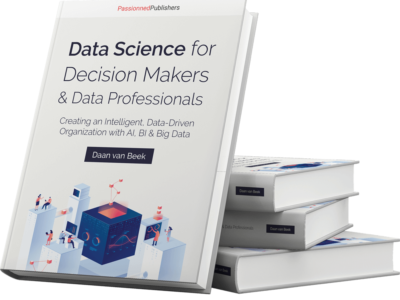What is data-driven working?
Data-driven working, also called data-driven steering, encompasses many facets both organizationally and technically. We give the following definition of data-driven working:
Data-driven working is the consistent, daily, weekly analysis and steering based on (raw) facts and data. You let data guide you in your daily work.
The goal is to gain more insight and knowledge daily and/or weekly and make more informed decisions based on reliable data. The goal is to structurally improve things in your organization or to innovate. Across the full breadth of the company.
We always think of concrete solutions for data-driven steering
Working in a data-driven way is very different from building a dashboard (with or without real KPIs) or creating a data warehouse. Technology is of course important but so are people! In order to achieve data-driven management, we are happy to help you practically solve concrete questions such as:
- How do you create the right awareness among managers and employees to start prioritizing data-driven working and how do you steer that change process in the right direction?
- On which facets does a data-driven organization excel and how do you complete the business case for data-driven management?
- Which decisions in your organization qualify for data-driven management and how do you go about achieving this?
- What types of data – open data, fast data, big data – all form input for data-driven working? What is the best architecture for all those forms of data?
- What risks and pitfalls should you be alert to in data-driven management and what precautions should you take?
- Which BI tools and methodologies are available to implement data-driven management?
Do one or more of these issues also play a role in your organization? Do you want a data-driven organization that acts on facts, emphasizes data-driven steering, and never loses its way? Then let Passionned Group’s data-driven improvement specialists advise you.
Data-driven work is a continuous process
A data-driven organization makes decisions on the fly. Because there is so much usable data, more than you will suspect. And the dynamics of our society are changing rapidly, so you have to make decisions more often. Here you have to remember that one political decision or a competitor’s decision can nullify all the (big) decisions of the past year. So above all, collect a lot of external data.
 Figure 1: What is data-driven work? The figure above shows the overall process.
Figure 1: What is data-driven work? The figure above shows the overall process.
The goal is to achieve a data-driven organization where everyone makes rational decisions based on data much more often than before. And no longer steers solely on the basis of gut feeling, assumptions, or opinions. From now on, you operate as a team in which everyone is on the same page.
How to have a data-driven organization?
Data-driven working is exactly the meaning you can attribute to this concept: you start working with data to be able to perform your work well and to make well-founded decisions.
To increase the adoption of data-driven working in your organization, you not only need to raise awareness but certainly also train your people to a certain level of data literacy.
In addition, you need Business Intelligence tools that allow you to create reports, interactive dashboards, and KPIs, but always look closely at data quality (measure & improve). Because contaminated data can unfortunately put a spoke in the wheel of your data-driven ambitions.
The concept container
Data-driven architecture does not stand alone. There are many concepts that combine to drive the development of a simple but solid data-driven architecture.
 Figure 2: The concept container as data-driven architecture
Figure 2: The concept container as data-driven architecture
To understand the essence of the word “data-driven,” you need to know them all. The most important concept is in the middle: data analysis. This is crucial to improving things.
Our unique Business Intelligence course can come in handy for that. You will learn all facets of data-driven work and you will also receive a signed copy of the handbook ‘Data Science Book‘.
The sister of data-driven working: information-driven working
Information-driven working often assumes a KPI. But these are sometimes very outdated or often not sharp enough. In information-driven working, you start exploring and analyzing principles and spearheads that have been hammered in beforehand. With data-driven working/steering, on the contrary, you start from the raw, unprocessed data and maximum freedom.
- Information-driven working leads to (even) more control of what is already there.
- Data-driven work, on the other hand, leads to much more creative and innovative solutions.
Both methods have their advantages and disadvantages.
Embrace data-driven work or…
Data-driven decisions are higher quality, more rational decisions. They produce higher profitability, better financial position, and higher customer satisfaction (Harvard, 2015). Andrew McAfee of MIT even states:
Employees who do not embrace the principle of data-driven work will soon be replaced by those who do.
This is especially true for executives. Perhaps in your organization and situation, it won’t be such a big deal, yet this is food for thought.
The data-driven organization and its benefits
The data-driven organization isn’t looking only at the past but also at the future. From accountability to steering to forecasting. On all 4 layers, you have work to do:
- How do you create a data-driven culture?
- How do you shape a data-driven strategy?
- How do you make data-driven decisions?
- How do you make employees data literate?
 Figure 3: The four layers of a data-driven organization.
Figure 3: The four layers of a data-driven organization.
Culture is the hardest thing to reverse. However you look at it, it starts at the top of the organization. They must consistently manage based on reliable numbers. So participate!
In addition, data-driven work must become a spearhead for the organization. Give it a place in the business strategy. You don’t just make data-driven decisions, you have to set up a process for that. Finally, train managers and employees until they are sufficiently data literate.
Data-driven work at the NHN Safety Region
 Together with the control room, ambulance services and a team of cardiologists from various hospitals, the North Holland Safety Region (in the Netherlands) developed a process dashboard based on data-driven working. They wanted to know how their cardiac patients with acute heart problems were being guided through the entire care chain and what improvements they could make in that process.
Together with the control room, ambulance services and a team of cardiologists from various hospitals, the North Holland Safety Region (in the Netherlands) developed a process dashboard based on data-driven working. They wanted to know how their cardiac patients with acute heart problems were being guided through the entire care chain and what improvements they could make in that process.
They first brought together raw data from various systems and plotted it on the acute cardiac care process. Then they went about analyzing that data meticulously and having a conversation with those directly involved about the data. Not just once, but daily and weekly.
In eighteen months, the turnaround time of the entire acute care process for cardiac patients, in which every second counts, was reduced by 20 minutes. Controlled and secured. A story that appeals to everyone: data that saves lives. There is no greater social relevance.
What tools can the data-driven organization have at its disposal?
To shape data-driven working not only are your people crucial, but having the right Business Intelligence tools also matters. These come in different shapes and sizes. There are more than 25 available in the Netherlands alone. The solutions that best fit our approach to data-driven management and method are Qlik, Tableau, Power BI, and Visual Analytics from SAS.
What are the benefits of a data-driven organization?
A data-driven organization has many advantages. Make them your own and develop a vision for your own organization because without that vision you cannot convince others.
- much better decisions are made in groups and based on data
- a high degree of transparency, the work becomes less boring
- your employees start believing in their work and the mission of the organization again
- a data-driven organization is a learning organization, making mistakes is allowed
- your customers experience much better service in a data-driven organization
- higher profitability and better financial position, better compliance
Just try to cash in on the above benefits. You need time to do that. But also expertise. We are happy to help you with that because our many years of experience and high-quality knowledge will certainly pay off.
Is my corporate culture ready for data-driven steering?
Yes, precisely because data-driven steering involves working with raw data, the culture of your company does not initially matter much. Our years of experience in implementing data-driven organizations and data-driven processes make it clear time and again that you can apply our approach in any company culture and in any sector. Provided, of course, that the data is available and you start acting on it.
Use information consistently for action and analysis
Educational institutions must also be data-driven. Because everyone gets involved and plays a role in reading, analyzing, polishing, and discussing the data, data-driven work can grow into an organization-wide success. Of course, we set up a customized process for each organization based on standards, making the investment relatively low.
5 steps to data-driven decisions
Organizations that consistently make data-driven decisions have four percent higher productivity and they make six percent more profit. That seems little, but if you make 1 million euros in profit, you’re already talking about EUR 60,000. And for that amount of money, you can build a nice BI system. Source: MIT Center for Digital Business.
Other studies show that success with BI leads to 33% more satisfied customers. And with IoT applications, we can achieve $63 billion in global healthcare savings in 15 years. So you’ll find many benefits of data-driven work in all sorts of areas.
So make data part of your company’s DNA now in five steps.
These are the outlines you need to make your organization data-driven. Do you really want to know the ins and outs? Then download our good-new white paper “The 101 Steps to BI Success” here.
Quick wins
To make a turnaround a success, we recommend focusing on a few easy quick wins at the start. Try to identify 3 to 5 of them. That way, you immediately create enthusiasm and energy for further change.
- Important principles
- Collect enough and the right data
- Let it flow throughout your organization
- Data is available everywhere and to everyone
- Data is fast and easy to read
Do you also want more profits, higher productivity, and happy customers? Then take the plunge and become a data-driven organization now. We are only too happy to help you with this. Because it is our passion!
More grip with data-driven processes
Because data-driven steering gives you more and much finer insight, and with great frequency, you can see where things are faltering in your business processes. The data and dashboards reveal where you should focus your analysis and where you can make adjustments. That’s how you get a better grip on your organization, improve performance and make your processes data-driven. But data science techniques and artificial intelligence (meaning) can also make an important contribution. After all, with reports and dashboards you are often running behind the facts.
The Data Science book for Decision Makers & Data Professionals  Any organization can become intelligent, but not without data-driven working in all layers of the company. The Data Science Book is sensitive, smart, agile, and successful and, with the right data, triggers a new improvement movement every time. In order to have data-driven processes, increase agility, and offer customers a higher quality of service and a nicer experience, order the book directly.
Any organization can become intelligent, but not without data-driven working in all layers of the company. The Data Science Book is sensitive, smart, agile, and successful and, with the right data, triggers a new improvement movement every time. In order to have data-driven processes, increase agility, and offer customers a higher quality of service and a nicer experience, order the book directly.
The examples really are there for the taking
The examples of data-driven work are literally there for the taking. We have already mentioned the Municipality of Rotterdam and the North Holland Safety Region. But these are not our only clients and success stories. In addition, we recently helped a health insurance company with the implementation of data-driven working, we provided the business branch of Rabobank with interactive dashboards, we created dashboards for a chain of gas stations, we introduced data-driven working at an elementary school and we advised a telecom company in data-driven management. Don’t wait any longer and get to know Passionned Group: together we will achieve success with data.
Get acquainted with data-driven steering
Do you want to implement data-driven work into the capillaries of your organization? Do you want to avoid the most common pitfalls and achieve data-driven success? Then feel free to contact one of our data-driven improvement specialists.
About Passionned Group
 Passionned Group is a leading specialist in data-driven working and data-driven management. Our passionate and experienced hands-on consultants and advisors help larger and smaller organizations in the transition to becoming intelligent, data-driven organizations. Every other year we organize the Dutch BI & Data Science Award™, a prestigious award for the Smartest organization in the Netherlands.
Passionned Group is a leading specialist in data-driven working and data-driven management. Our passionate and experienced hands-on consultants and advisors help larger and smaller organizations in the transition to becoming intelligent, data-driven organizations. Every other year we organize the Dutch BI & Data Science Award™, a prestigious award for the Smartest organization in the Netherlands. Frequently Asked Questions
What does data-driven working require from managers?The will to consistently manage based on insights and reliable data. And bringing the team along with them. Finally: an analytical view and attitude.
What is the difference between data-driven working and agile working?
Agile working focuses on speed and an agile organization, data-driven working on making reliable decisions. You can easily combine them because they fit together.
How can you learn to do data-driven work yourself?
Figure out what decisions you make and what insights you need to make the best decision. Then find the data to go with it.
Is data-driven work difficult?
The basics are easy, but to implement them in an organization is quite a task. After all, not every manager and employee has the right skills and competencies.
What is at the heart of data-driven work?
Peering at a dashboard with KPIs or peeking at a graph makes no difference. You have to initiate/perform data analysis when there are (large) deviations to find out what the problem is that needs to be solved.
Are there any drawbacks to a data-driven organization?
Certainly, the more transparency the greater the chance of intervention from outside or above. And that is certainly not desirable in all cases. By measuring everything loosely, you probably also destroy creativity and innovation in your organization.
How do you determine KPIs?
Several methods can help you with that: strategy-driven, process-driven, or data-driven. Read more about the methods and how to set KPIs in our SMART KPI Guide 2025.






